Nanocellulose-Linked MXene/Polyaniline Aerogel Films for Flexible Supercapacitors
Abstract
1. Introduction
2. Results and Discussion
2.1. Characterisation of MXene/CNF Aerogel Films and MXene/CNF–PANI Aerogel Films
2.1.1. Scanning Electron Microscopy (SEM) Analysis
2.1.2. Fourier Transform Infrared (FTIR) Analysis
2.1.3. X-ray Diffraction (XRD) Analysis
2.1.4. Tensile Stress–Strain Analysis
2.2. Electrochemical Performance of MXene/CNF Aerogel Films and MXene/CNF–PANI Aerogel Films
3. Conclusions
4. Materials and Methods
4.1. Materials
4.2. Characterisation
4.3. Preparation of MXene, MXene/CNF Aerogel Films and MXene/CNF-PANI Aerogel Films
4.4. Electrochemical Performance of MXene, MXene/CNFs Aerogel Films and MXene/CNFs-PANI Aerogel Films
Author Contributions
Funding
Institutional Review Board Statement
Informed Consent Statement
Data Availability Statement
Conflicts of Interest
References
- Tomain, J.P. A perspective on clean power and the future of US energy politics and policy. Util. Policy 2016, 39, 5–12. [Google Scholar] [CrossRef]
- El-Mahdy, A.F.M.; Mohamed, M.G.; Mansoure, T.H.; Yu, H.H.; Chen, T.; Kuo, S.W. Ultrastable tetraphenyl-p-phenylenediaminebased covalent organic frameworks as platforms for high-performance electrochemical supercapacitors. Chem. Commun. 2019, 55, 14890–14893. [Google Scholar] [CrossRef]
- Goonetilleke, D.; Sharma, N.; Pang, W.K.; Peterson, V.K.; Petibon, R.; Li, J.; Dahn, J.R. Structural Evolution and High-Voltage Structural Stability of Li(NixMnyCoz)O2 Electrodes. Chem. Mater. 2019, 31, 376–386. [Google Scholar] [CrossRef]
- Jiang, G.Y.; Wang, G.; Zhu, Y.; Cheng, W.K.; Cao, K.Y.; Xu, G.W.; Zhao, D.W.; Yu, H.P. A Scalable Bacterial Cellulose Ionogel for Multisensory Electronic Skin. Research 2022, 2022, 9814767. [Google Scholar] [CrossRef]
- Ge, W.J.; Cao, S.; Yang, Y.; Rojas, O.J.; Wang, X.H. Nanocellulose/LiCl systems enable conductive and stretchable electrolyte hydrogels with tolerance to dehydration and extreme cold conditions. Chem. Eng. J. 2021, 408, 127306. [Google Scholar] [CrossRef]
- Wan, C.C.; Jiao, Y.; Liang, D.X.; Wu, Y.Q.; Li, J. A Geologic Architecture System-Inspired Micro-/Nano-Heterostructure Design for High-Performance Energy Storage. Adv. Energy Mater. 2018, 8, 1802388. [Google Scholar] [CrossRef]
- Javed, M.S.; Shah, S.S.A.; Najam, T.; Siyal, S.H.; Hussain, S.; Saleem, M.; Zhao, Z.; Mai, W. Achieving high-energy density and superior cyclic stability in flexible and lightweight pseudocapacitor through synergic effects of binder-free CoGa2O4 2D-hexagonal nanoplates. Nano Energy 2020, 77, 105276. [Google Scholar] [CrossRef]
- Doustkhah, E.; Hassandoost, R.; Khataee, A.; Luque, R.; Assadi, M.H.N. Hard-templated metal-organic frameworks for advanced applications. Chem. Soc. Rev. 2021, 50, 2927–2953. [Google Scholar] [CrossRef]
- Rashidi, N.A.; Chai, Y.H.; Ismail, I.S.; Othman, M.F.H.; Yusup, S. Biomass as activated carbon precursor and potential in supercapacitor applications. Biomass Convers. Biorefinery 2022, 45, 649–657. [Google Scholar] [CrossRef]
- Li, S.; Liu, Y.; Zhao, X.; Shen, Q.; Zhao, W.; Tan, Q.; Zhang, N.; Li, P.; Jiao, L.; Qu, X. Sandwich-Like Heterostructures of MoS2/Graphene with Enlarged Interlayer Spacing and Enhanced Hydrophilicity as High-Performance Cathodes for Aqueous Zinc-Ion Batteries. Adv. Mater. 2021, 33, e2007480. [Google Scholar] [CrossRef]
- Zheng, Z.; Zheng, Y.; Luo, Y.; Yi, Z.; Zhang, J.; Liu, Z.; Yang, W.; Yu, Y.; Wu, X.; Wu, P. A switchable terahertz device combining ultra-wideband absorption and ultra-wideband complete reflection. Phys. Chem. Chem. Phys. 2022, 24, 2527–2533. [Google Scholar] [CrossRef] [PubMed]
- Tian, W.; VahidMohammadi, A.; Reid, M.S.; Wang, Z.; Ouyang, L.; Erlandsson, J.; Pettersson, T.; Wagberg, L.; Beidaghi, M.; Hamedi, M.M. Multifunctional Nanocomposites with High Strength and Capacitance Using 2D MXene and 1D Nanocellulose. Adv. Mater. 2019, 31, e1902977. [Google Scholar] [CrossRef]
- Wen, Y.; Li, R.; Liu, J.; Wei, Z.; Li, S.; Du, L.; Zu, K.; Li, Z.; Pan, Y.; Hu, H. A temperature-dependent phosphorus doping on Ti3C2Tx MXene for enhanced supercapacitance. J. Colloid Interface Sci. 2021, 604, 239–248. [Google Scholar] [CrossRef] [PubMed]
- Jalali, H.; Khoeini, F.; Peeters, F.M.; Neek-Amal, M. Hydration effects and negative dielectric constant of nano-confined water between cation intercalated MXenes. Nanoscale 2021, 13, 922–929. [Google Scholar] [CrossRef] [PubMed]
- Javed, M.S.; Mateen, A.; Ali, S.; Zhang, X.; Hussain, I.; Imran, M.; Shah, S.S.A.; Han, W. The Emergence of 2D MXenes Based Zn-Ion Batteries: Recent Development and Prospects. Small 2022, 18, e2201989. [Google Scholar] [CrossRef]
- Bai, Y.; Liu, C.; Chen, T.; Li, W.; Zheng, S.; Pi, Y.; Luo, Y.; Pang, H. MXene-Copper/Cobalt Hybrids via Lewis Acidic Molten Salts Etching for High Performance Symmetric Supercapacitors. Angew. Chem. Int. Ed. 2021, 60, 25318–25322. [Google Scholar] [CrossRef]
- Anasori, B.; Lukatskaya, M.R.; Gogotsi, Y. 2D metal carbides and nitrides (MXenes) for energy storage. Nat. Rev. Mater. 2017, 2, 16098. [Google Scholar] [CrossRef]
- Javed, M.S.; Shaheen, N.; Hussain, S.; Li, J.; Shah, S.S.A.; Abbas, Y.; Ahmad, M.A.; Raza, R.; Mai, W. An ultra-high energy density flexible asymmetric supercapacitor based on hierarchical fabric decorated with 2D bimetallic oxide nanosheets and MOF-derived porous carbon polyhedra. J. Mater. Chem. A 2019, 7, 946–957. [Google Scholar] [CrossRef]
- Zhang, Y.; Chen, P.; Wang, Q.; Wang, Q.; Zhu, K.; Ye, K.; Wang, G.; Cao, D.; Yan, J.; Zhang, Q. High-Capacity and Kinetically Accelerated Lithium Storage in MoO3 Enabled by Oxygen Vacancies and Heterostructure. Adv. Energy Mater. 2021, 11, 2101712. [Google Scholar] [CrossRef]
- Javed, M.S.; Zhang, X.; Ali, S.; Mateen, A.; Idrees, M.; Sajjad, M.; Batool, S.; Ahmad, A.; Imran, M.; Najam, T.; et al. Heterostructured bimetallic–sulfide@layered Ti3C2Tx–MXene as a synergistic electrode to realize high-energy-density aqueous hybrid-supercapacitor. Nano Energy 2022, 101, 107624. [Google Scholar] [CrossRef]
- Nallapureddy, R.R.; Pallavolu, M.R.; Joo, S.W. Construction of Functionalized Carbon Nanofiber-g-C3N4 and TiO2 Spheres as a Nanostructured Hybrid Electrode for High-Performance Supercapacitors. Energy Fuels 2021, 35, 1796–1809. [Google Scholar] [CrossRef]
- Bao, Q.; Bao, S.; Li, C.M.; Qi, X.; Pan, C.; Zang, J.; Lu, Z.; Li, Y.; Tang, D.Y.; Zhang, S.; et al. Supercapacitance of solid carbon nanofibers made from ethanol flames. J. Phys. Chem. C 2008, 112, 3612–3618. [Google Scholar] [CrossRef]
- Tian, N.; Wu, S.H.; Han, G.T.; Zhang, Y.M.; Li, Q.; Dong, T. Biomass-derived oriented neurovascular network-like superhydrophobic aerogel as robust and recyclable oil droplets captor for versatile oil/water separation. J. Hazard. Mater. 2022, 424, 127393. [Google Scholar] [CrossRef]
- Luo, S.; Xiang, T.; Dong, J.; Su, F.; Ji, Y.; Liu, C.; Feng, Y. A double crosslinking MXene/cellulose nanofiber layered film for improving mechanical properties and stable electromagnetic interference shielding performance. J. Mater. Sci. Technol. 2022, 129, 127–134. [Google Scholar] [CrossRef]
- Wang, Y.; Ma, L.; Xu, F.; Ren, R.; Wang, J.; Hou, C. Ternary ZIF-67/MXene/CNF aerogels for enhanced photocatalytic TBBPA degradation via peroxymonosulfate activation. Carbohydr. Polym. 2022, 298, 120100. [Google Scholar] [CrossRef]
- Huang, H.; Dong, Y.; Wan, S.; Shen, J.; Li, C.; Han, L.; Dou, G.; Sun, L. A transient dual-type sensor based on MXene/cellulose nanofibers composite for intelligent sedentary and sitting postures monitoring. Carbon 2022, 200, 327–336. [Google Scholar] [CrossRef]
- Wu, N.; Yang, Y.; Wang, C.; Wu, Q.; Pan, F.; Zhang, R.; Liu, J.; Zeng, Z. Ultrathin Cellulose Nanofiber Assisted Ambient-Pressure-Dried, Ultralight, Mechanically Robust, Multifunctional MXene Aerogels. Adv. Mater. 2022, e2207969. [Google Scholar] [CrossRef]
- Fang, Y.-S.; He, P.; Cai, Y.-Z.; Cao, W.-Q.; Cao, M.-S. Bifunctional Ti3C2Tx-CNT/PANI composite with excellent electromagnetic shielding and supercapacitive performance. Ceram. Int. 2021, 47, 25531–25540. [Google Scholar] [CrossRef]
- Lyu, W.; Li, J.; Zheng, L.; Liu, H.; Chen, J.; Zhang, W.; Liao, Y. Fabrication of 3D compressible polyaniline/cellulose nanofiber aerogel for highly efficient removal of organic pollutants and its environmental-friendly regeneration by peroxydisulfate process. Chem. Eng. J. 2021, 414, 128931. [Google Scholar] [CrossRef]
- Mahmoud, Z.H.; Al-Bayati, R.A.; Khadom, A.A. Synthesis and supercapacitor performance of polyaniline-titanium dioxide-samarium oxide (PANI/TiO2-Sm2O3) nanocomposite. Chem. Pap. 2022, 76, 1401–1412. [Google Scholar] [CrossRef]
- Singh, G.; Kumar, Y.; Husain, S. Improved electrochemical performance of symmetric polyaniline/activated carbon hybrid for high supercapacitance: Comparison with indirect capacitance. Polym. Adv. Technol. 2021, 32, 4490–4501. [Google Scholar] [CrossRef]
- Liu, J.; Ma, X.; Zi, Z. Proton Acid Doped Superior Capacitive Performances of Pseudocapacitance Electrodes for Energy Storage. Chemelectrochem 2022, 9, e202200082. [Google Scholar] [CrossRef]
- Yang, Z.X.; Yang, D.; Zhao, X.Z.; Zhao, Q.Y.; Zhu, M.; Liu, Y.; Wang, Y.; Lu, W.H.; Qi, D.P. From liquid metal to stretchable electronics: Overcoming the surface tension. Sci. China-Mater. 2022, 65, 2072–2088. [Google Scholar] [CrossRef]
- Xu, C.; Jiang, W.-Y.; Guo, L.; Shen, M.; Li, B.; Wang, J.-Q. High supercapacitance performance of nitrogen-doped Ti3C2Tx prepared by molten salt thermal treatment. Electrochim. Acta 2022, 403, 139528. [Google Scholar] [CrossRef]
- Jose, J.; Jose, S.P.; Prasankumar, T.; Shaji, S.; Pillai, S.; Sreeja, P.B. Emerging ternary nanocomposite of rGO draped palladium oxide/polypyrrole for high performance supercapacitors. J. Alloy. Compd. 2021, 855, 157481. [Google Scholar] [CrossRef]
- Wu, N.; Zhao, W.; Zhou, B.; Wu, Y.; Hou, W.; Xu, W.; Du, J.; Zhong, W. 3D nitrogen-doped Ti3C2Tx/rGO foam with marco- and microporous structures for enhance supercapacitive performance. Electrochim. Acta 2022, 404, 139852. [Google Scholar] [CrossRef]
- Tang, Y.; Zhu, J.; Yang, C.; Wang, F. Enhanced supercapacitive performance of manganese oxides doped two-dimensional titanium carbide nanocomposite in alkaline electrolyte. J. Alloy. Compd. 2016, 685, 194–201. [Google Scholar] [CrossRef]
- Habib, I.; Ferrer, P.; Ray, S.C.; Ozoemena, K.I. Interrogating the impact of onion-like carbons on the supercapacitive properties of MXene (Ti2CTX). J. Appl. Phys. 2019, 126, 134301. [Google Scholar] [CrossRef]
- Chen, W.; Li, Z.; Jiang, F.; Luo, M.; Yang, K.; Zhang, D.; Xu, W.; Liu, C.; Zhou, X. Water Evaporation Triggered Self--Assembly of MXene on Non--Carbonized Wood with Well--Aligned Channels as Size--Customizable Free--Standing Electrode for Supercapacitors. Energy Environ. Mater. 2022, 126, 134301. [Google Scholar] [CrossRef]
- Na, Y.W.; Cheon, J.Y.; Kim, J.H.; Jung, Y.; Lee, K.; Park, J.S.; Park, J.Y.; Song, K.S.; Lee, S.B.; Kim, T.; et al. All-in-one flexible supercapacitor with ultrastable performance under extreme load. Sci. Adv. 2022, 8, eabl8631. [Google Scholar] [CrossRef]
- Wu, Y.; Sun, S.; Geng, A.; Wang, L.; Song, C.; Xu, L.; Jia, C.; Shi, J.; Gan, L. Using TEMPO-oxidized-nanocellulose stabilized carbon nanotubes to make pigskin hydrogel conductive as flexible sensor and supercapacitor electrode: Inspired from a Chinese cuisine. Compos. Sci. Technol. 2020, 196, 108226. [Google Scholar] [CrossRef]
- Chen, Z.; Peng, X.; Zhang, X.; Jing, S.; Zhong, L.; Sun, R. Facile synthesis of cellulose-based carbon with tunable N content for potential supercapacitor application. Carbohydr. Polym. 2017, 170, 107–116. [Google Scholar] [CrossRef] [PubMed]
- Deng, L.; Young, R.J.; Kinloch, I.A.; Abdelkader, A.M.; Holmes, S.M.; De Haro-Del Rio, D.A.; Eichhorn, S.J. Supercapacitance from Cellulose and Carbon Nanotube Nanocomposite Fibers. ACS Appl. Mater. Interfaces 2013, 5, 9983–9990. [Google Scholar] [CrossRef]
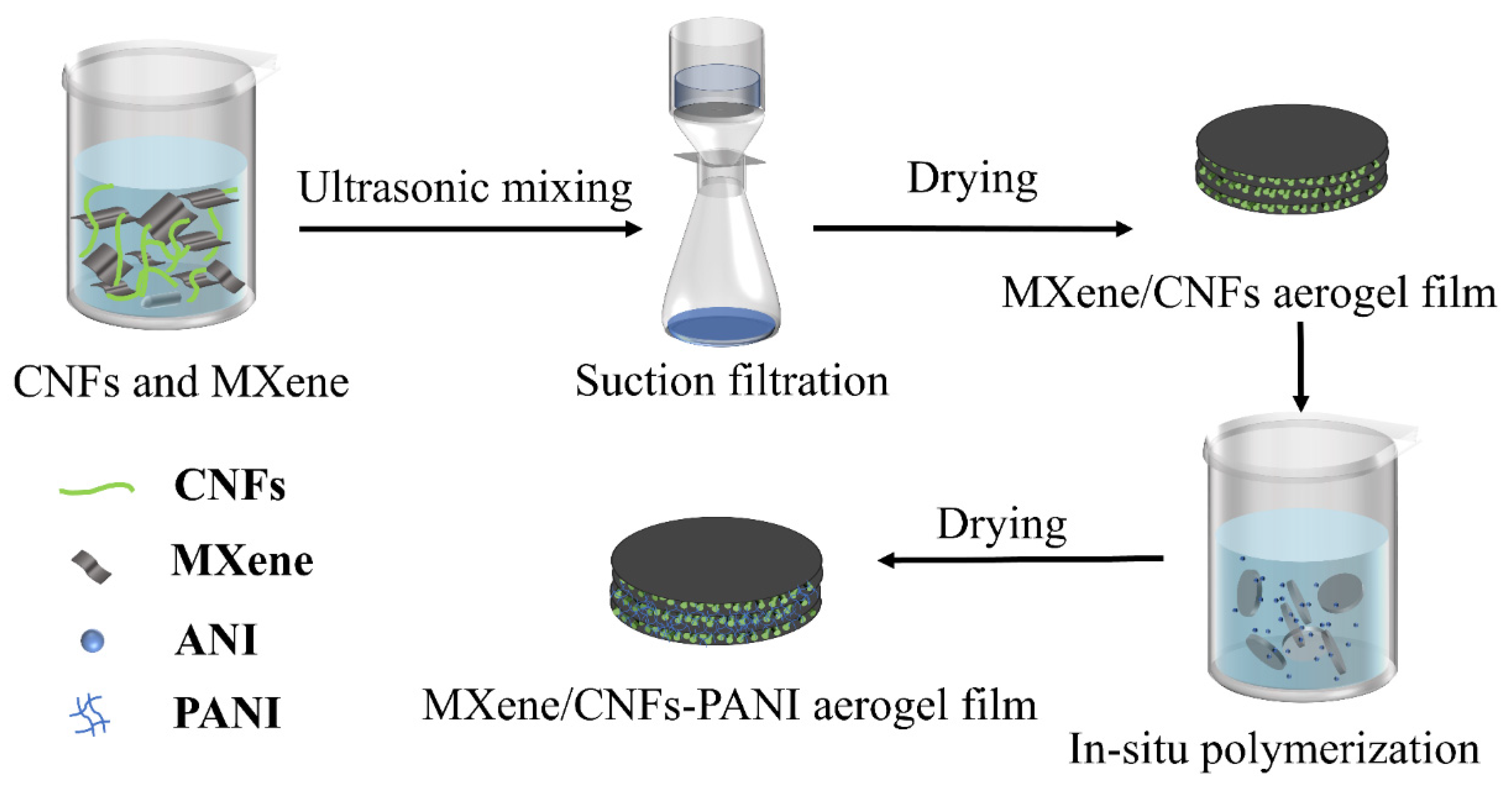
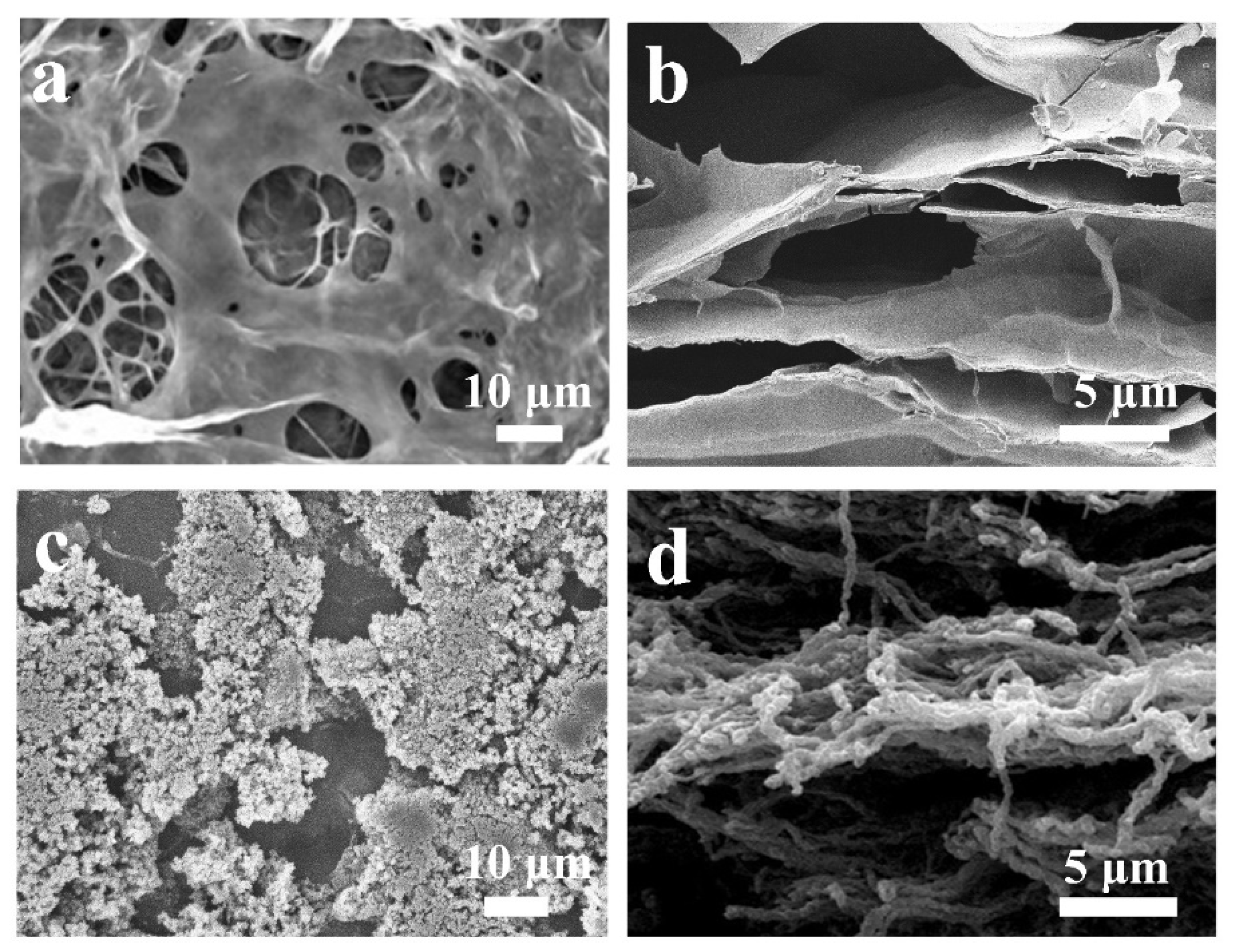
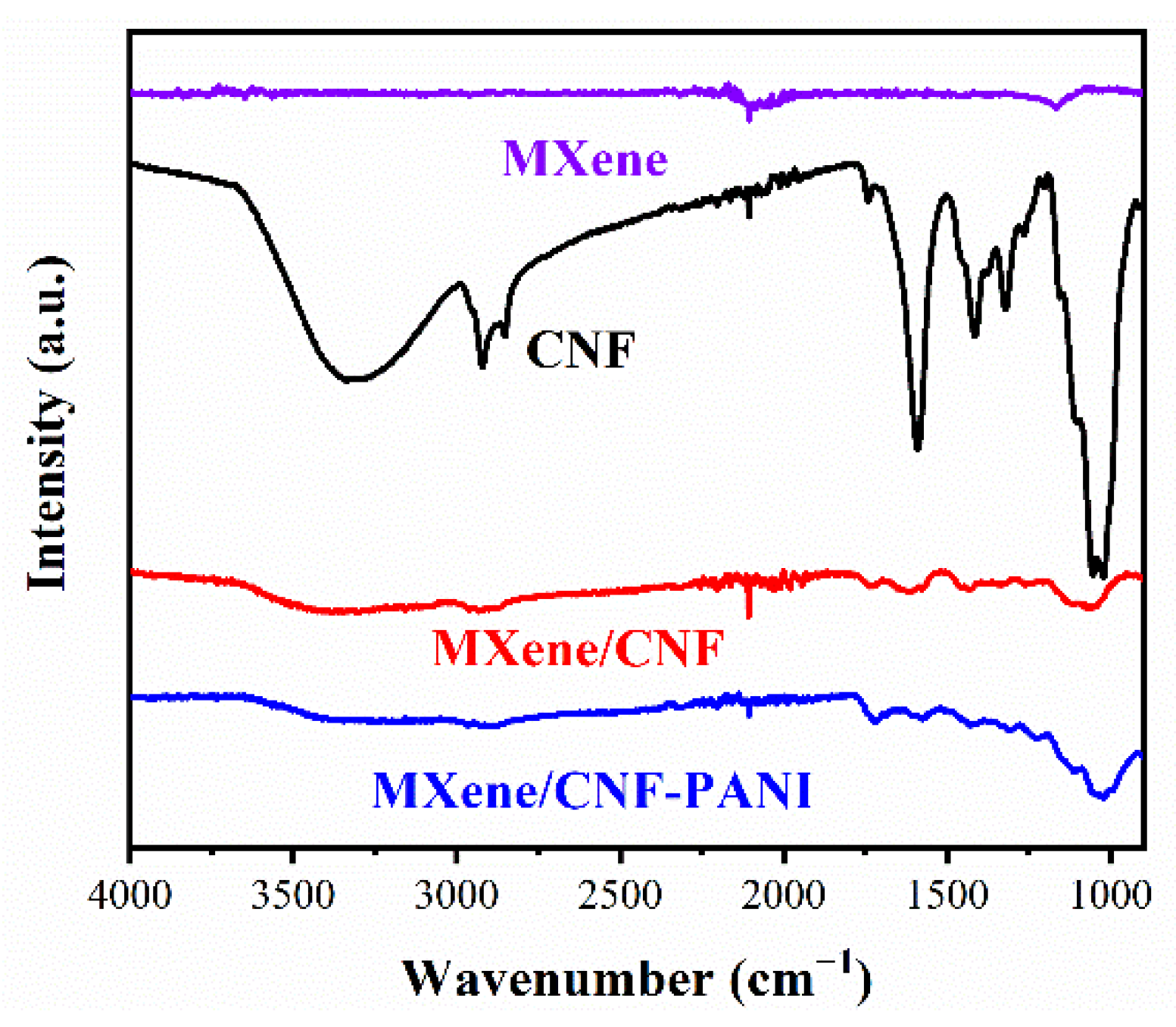
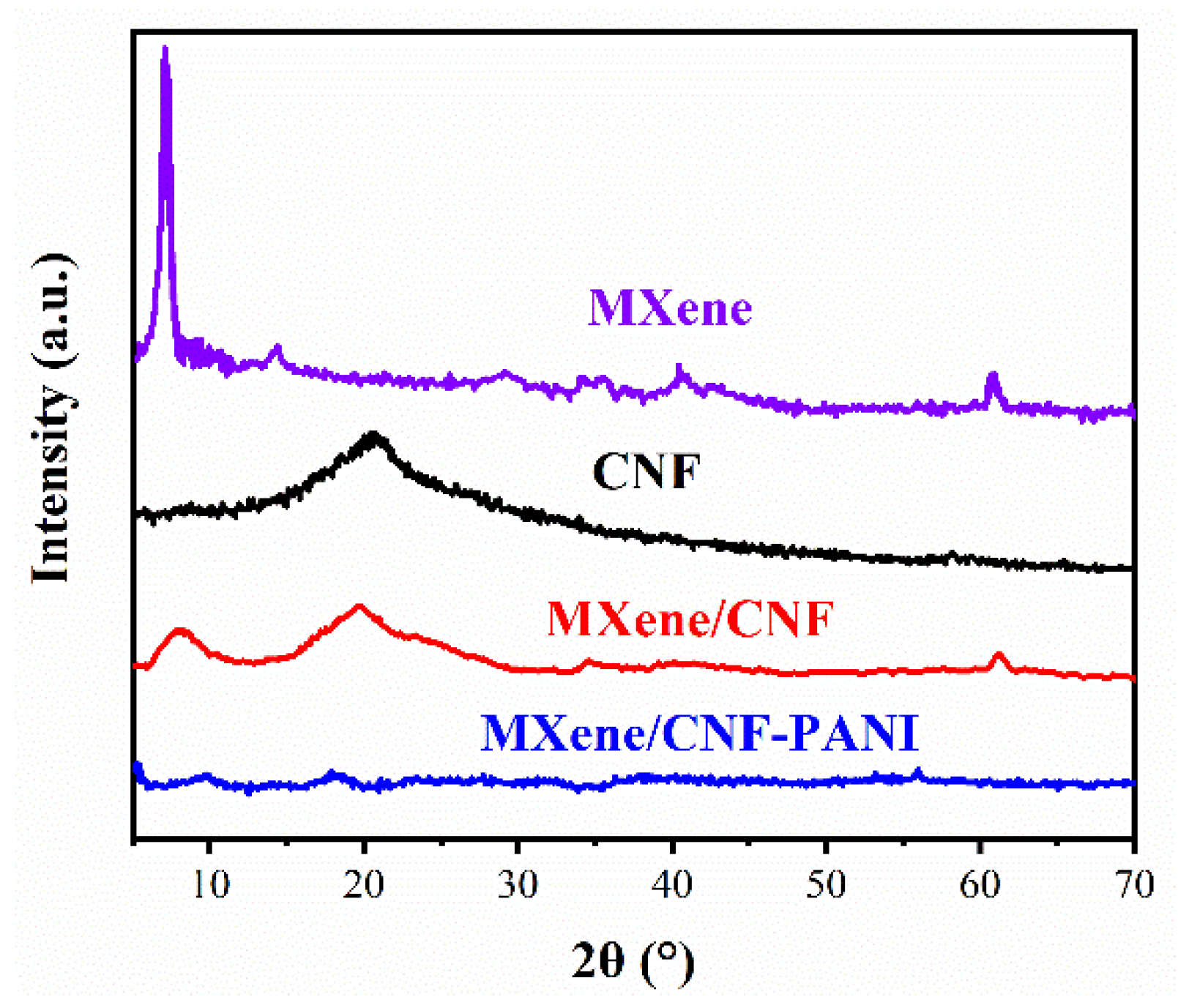
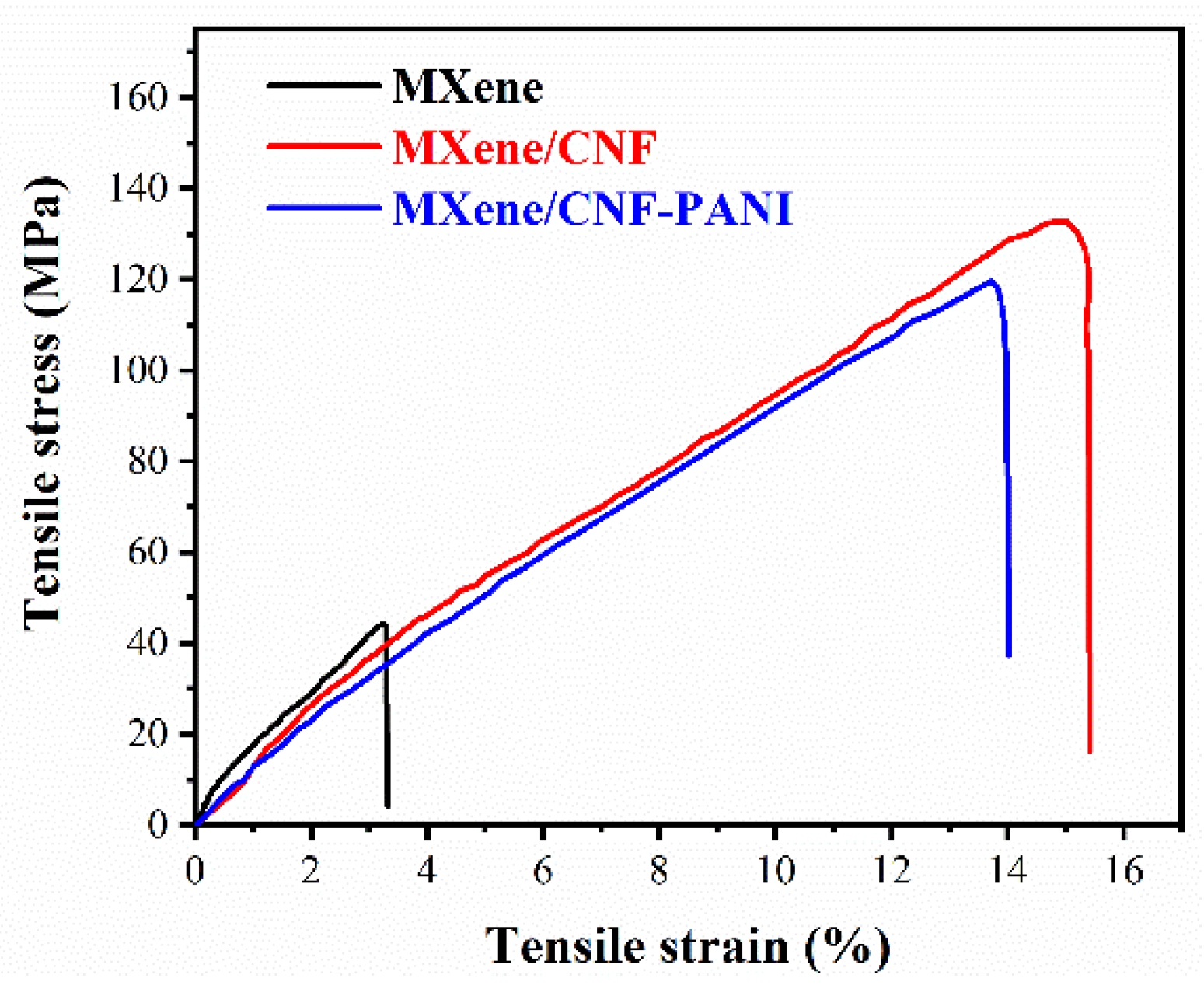

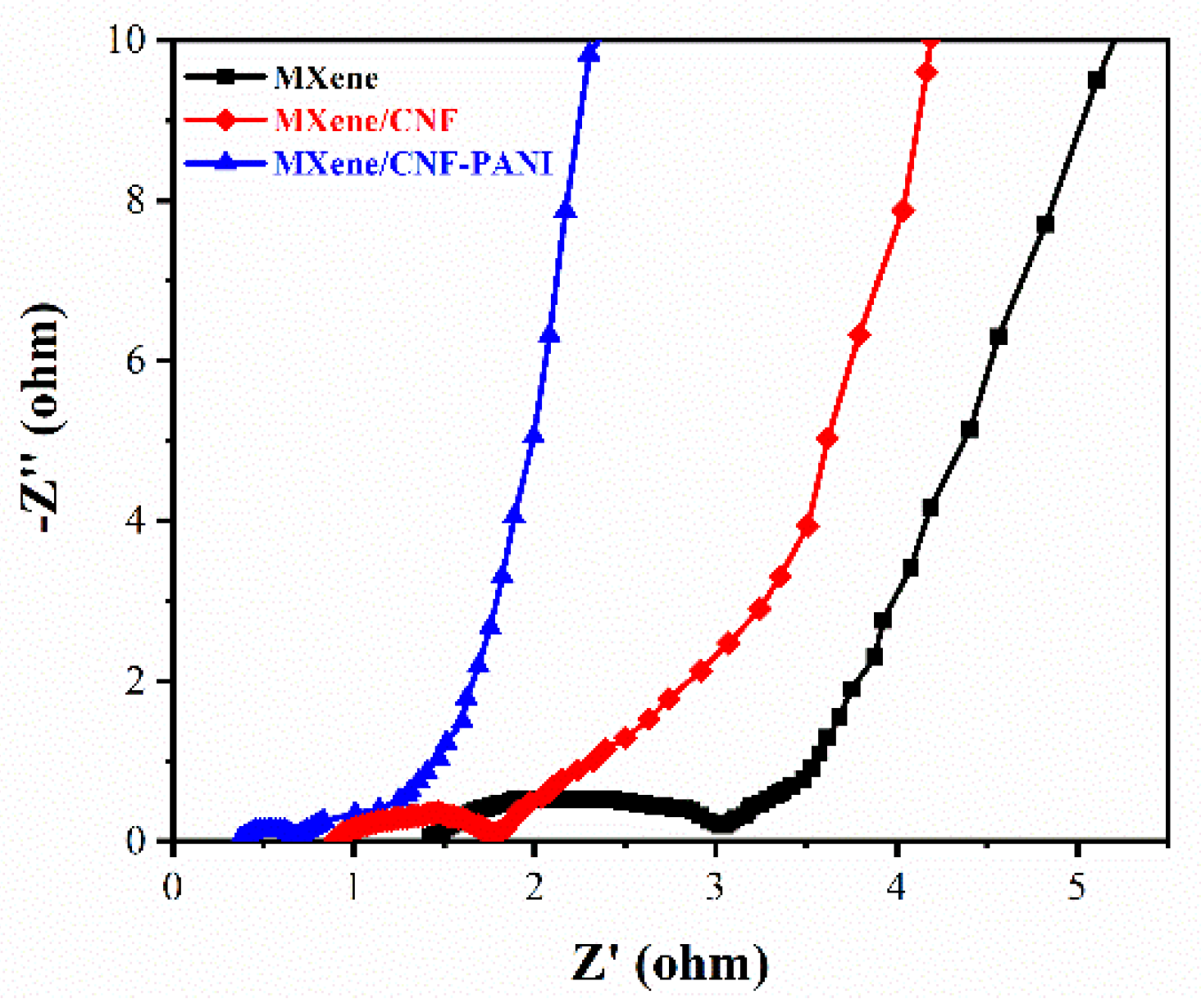
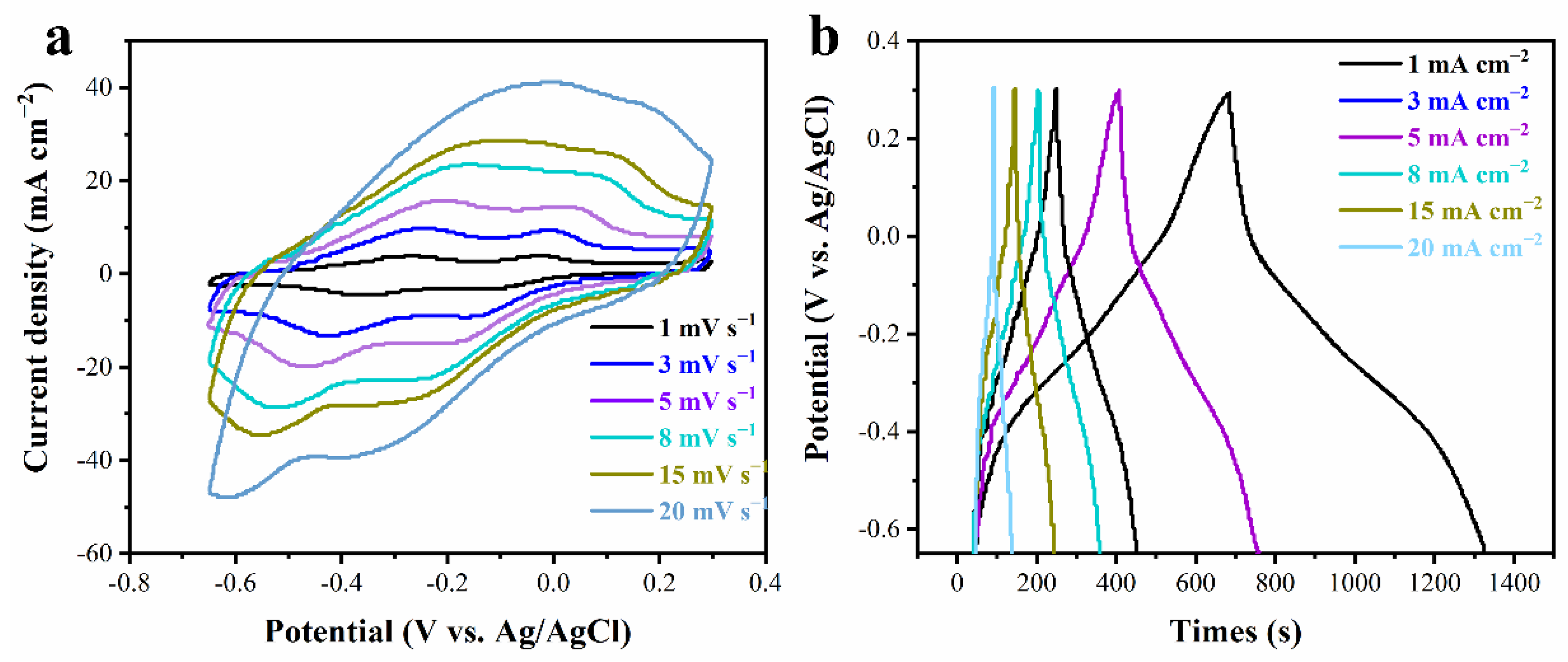
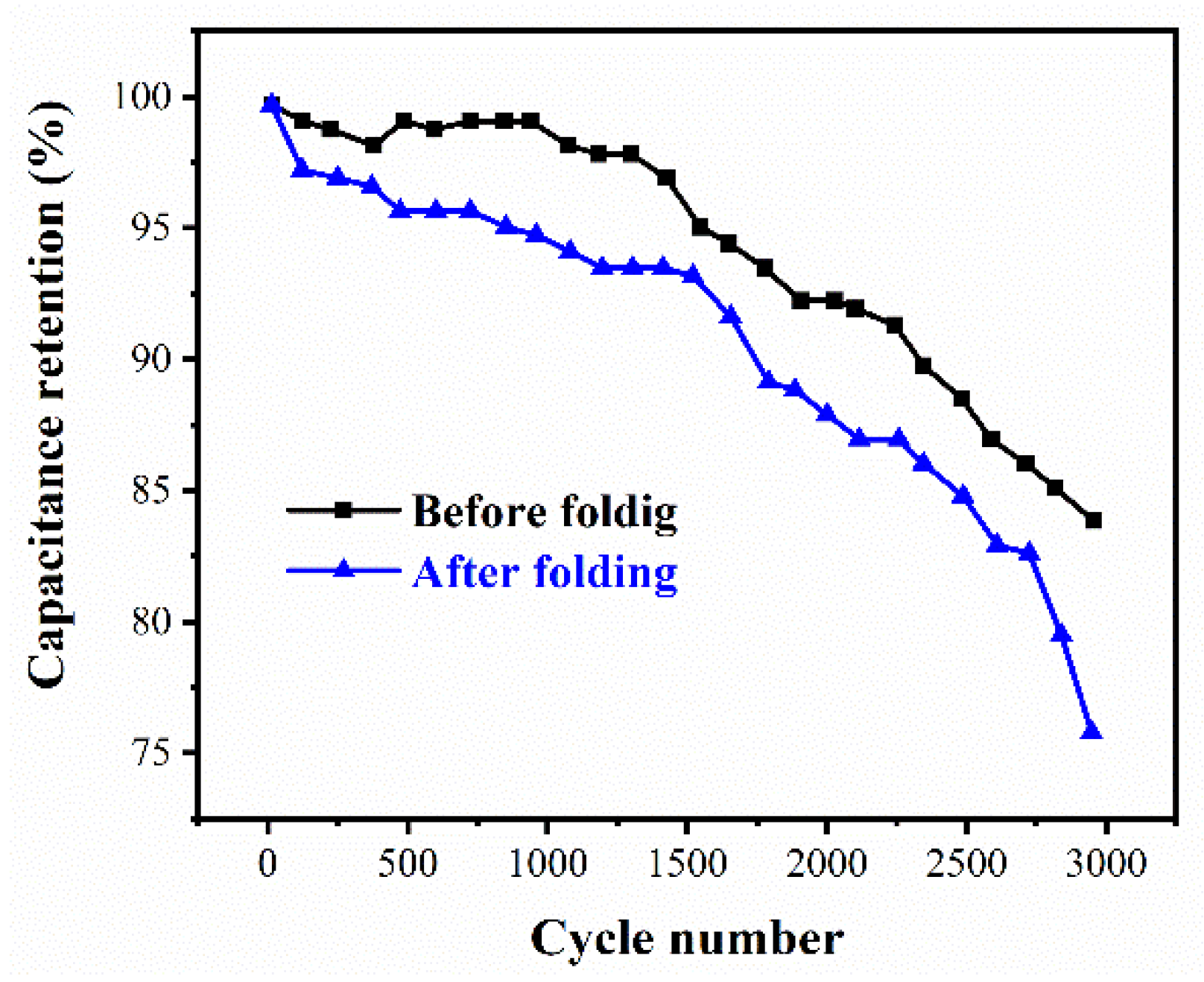
| Composites | Capacitance | Mechanical Properties (MPa) | Resistance (Ω) | Ref. |
|---|---|---|---|---|
| TEMPO-oxidized-nanocellulose carbon nanotubes | 65 F g−1 | 0.065 | 26 | [41] |
| N-doped porous carbon | 193 F g−1 | --- | 0.97 | [42] |
| Ti3C2Tx/CNF | 298 F g−1 | 0.004 | 0.003 | [12] |
| MWNT/cellulose nanofibers | 145 F g−1 | --- | 0.37 | [43] |
| Brazilian-pine fruit coat | 0.87 F cm−2 | 6.1 | 13.5 | [39] |
| MXene/CNF–PANI | 327 F g−1 | 119.56 | 0.23 | This study |
Publisher’s Note: MDPI stays neutral with regard to jurisdictional claims in published maps and institutional affiliations. |
© 2022 by the authors. Licensee MDPI, Basel, Switzerland. This article is an open access article distributed under the terms and conditions of the Creative Commons Attribution (CC BY) license (https://creativecommons.org/licenses/by/4.0/).
Share and Cite
Xu, L.; Wang, W.; Liu, Y.; Liang, D. Nanocellulose-Linked MXene/Polyaniline Aerogel Films for Flexible Supercapacitors. Gels 2022, 8, 798. https://doi.org/10.3390/gels8120798
Xu L, Wang W, Liu Y, Liang D. Nanocellulose-Linked MXene/Polyaniline Aerogel Films for Flexible Supercapacitors. Gels. 2022; 8(12):798. https://doi.org/10.3390/gels8120798
Chicago/Turabian StyleXu, Liying, Wenxuan Wang, Yu Liu, and Daxin Liang. 2022. "Nanocellulose-Linked MXene/Polyaniline Aerogel Films for Flexible Supercapacitors" Gels 8, no. 12: 798. https://doi.org/10.3390/gels8120798
APA StyleXu, L., Wang, W., Liu, Y., & Liang, D. (2022). Nanocellulose-Linked MXene/Polyaniline Aerogel Films for Flexible Supercapacitors. Gels, 8(12), 798. https://doi.org/10.3390/gels8120798







